July 1, 1996
THESIS WORK
My Masters Of Fine Arts Thesis Exhibition concentrated on two projects, a computer generated short animated feature and a virtual reality environment. Both of these are rooted in surrealism and transformations, but each had a different focus. The animation "A Small Comfort" focuses on motion and story, while the virtual reality environment "ORGWORLD" deals with environment and behavior.
A SMALL COMFORT
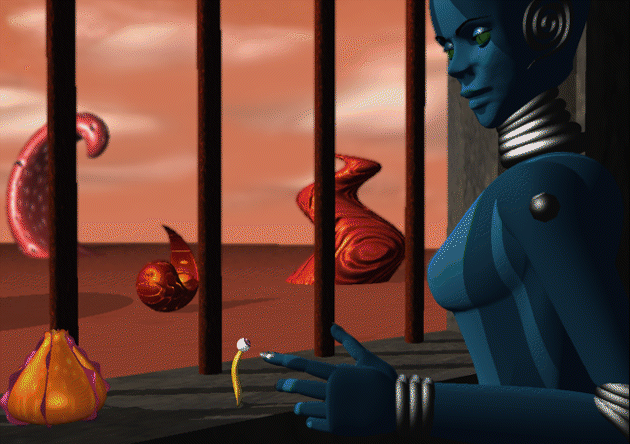 |
|---|
| Closing Scene from "A Small Comfort" |
"A Small Comfort" is a story of life, death, transformation and regeneration. An imprisoned woman gazes through the window of her cell at a surreal landscape filled with gently undulating life forms. She dreams of freedom, but even more so, for a companion to ease her solitude. Through a mysterious process she is transformed into a cat and her freedom is granted. However, while free she commits an act of violence against one of the environment's inhabitants. Her freedom is taken from her again, but she does get her companion, the "small comfort".
This 2 minute and 40 second work took about five months to complete. The five steps involved were storyboarding, modeling, animating, rendering, and editing.
Storyboard
The first and most important step in creating the animation was the storyboard. For a project of this scale, with a tight deadline, it was essential that all the details of the story had been worked out prior to commencing production. After numerous revisions, the storyboard was finalized, and then followed very closely.
Models
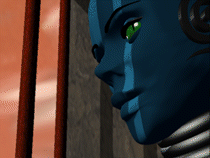 |
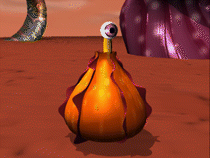 |
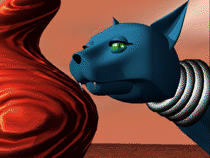 |
|---|---|---|
| The Woman | The Critter | The Cat |
The next step was creating the models. First character designs were sketched on paper, and when details were worked out, the modeling began. The three main characters - the woman, the cat, and the critter, were modeled using Softimage. All models used NURBS to ensure a more free-flowing appearance and to offer better control when editing points.
The woman and the cat are similar in appearance; the cat is the woman's alter ego. They are a hybrid of the living and the robotic, with blue skin, green eyes with slit-like pupils, platinum joints and metallic nails and teeth. They are made of many small moveable parts which remain rigid when the character moves. This is in contrast to the critter, who is soft, organic, and deformable. Correct modeling of the character components was a critical factor for accurate and realistic motion. Models needed to be designed and assembled correctly so they could be animated properly. Books on cat and human anatomy were an essential resource.
The models of the organic lifeforms in the landscape were created using my own homegrown software, the Interactive Object Transformation Animator (IOTA). IOTA is a utility programmed in C and GL where transformations such as bends and twists can be applied to 3D primitives in real time. When the desired shape is reached, the new object can be saved as a Wavefront file, and ultimately imported into Softimage. All the lifeforms in the animation were created this way, each being a variation of a paraboloid. IOTA allows for the creation of many interesting and unexpected forms that would have been difficult if not impossible to model in Softimage. Once in Softimage, the models were textured with layers of glistening bump-maps.
Animation
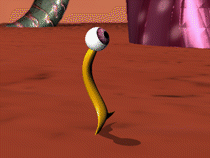 |
 |
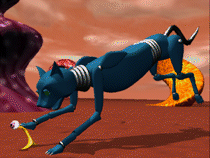 |
|---|---|---|
| Walking Critter | Stalking Cat | Leaping Cat |
After the models were created, the next step was to animate them. The most difficult and important character to animate was the cat. It was essential that its movement be realistic, because it is the focus of the whole story and climax of the animation. Nature programs featuring cats, real cats, Muybridge's "Animals in Motion" as well as "How Mammals Run: Anatomical Adaptations" by P.P. Gambaryan were all helpful. Slow motion was added to the pounce to accentuate the motion and build tension.
The animation of the critter was easier because it was an imaginary creature; the viewer would not expect realistic motion. It had a curious and friendly nature with an exaggerated bouncy, waddling walk. The woman did not move much, but expressed emotion with her eyes and hands. The lifeforms in the landscape each had different motion, but all moved very slowly and rythmically in a fashion reminiscent of sea anemones.
Rendering
Rendering was done in various stages. First low resolution test of segments were rendered at half or quarter size with raytracing and other non-essentials turned off. This allowed for careful evaluation of motion and timing so the necessary modifications could be made. Not until the movement was exactly right was the final rendering done. Overall this worked out very well, but at times there were unpleasant surprises when viewing what was to have been the final render. For example, certain problems with jittery bump-mapped textures did not show up in the smaller tests, and required a lot of reworking.Rendering out the final 4,650 frames that comprised the animation took about three weeks. Most of it was done at night utilizing as many CPUs as possible on available Silicon Graphics (SGI) Reality Engines. Depending on the scene, the time to render each frame varied between 30 seconds per frame to 10 minutes per frame. Slow rendering times were due to raytracing: the more shadows and reflections to be computed, the longer it took.
Editing
After all the scenes were rendered, segments of about 10 seconds were output to Betacam SP tape, utilizing the Sirius video out option from the SGI Reality Engine. These segments were output using dmovie, a movie playback utility. Real-time playback of rendered segments was limited to a maximum of 20 seconds or about 600 frames, due to the RAM limitations of the machine. I created my scenes with this in mind, carefully placing camera cuts so segments could be edited together seamlessly. After the edited piece was done, the soundtrack was created. Pamala Bublitz composed a score for solo violin after watching the animation. The final soundtrack was recorded to DAT at Streeterville Studios in Chicago. The musician watched the animation while performing to aid in synchronization with the on-screen motion. All the recorded tracks were mixed down to a two channel DAT. A sync point was selected on both the DAT and video tape, which allowed for perfect synchronization of the soundtrack with the animation in post-production.
Summary
"A Small Comfort" is a computer generated short animated feature focusing on story and motion. It tells a tale of life, death, transformation and regeneration, featuring the actions of an imprisoned woman, a stalking cat, and curious creature in a surreal and alien world.
ORGWORLD
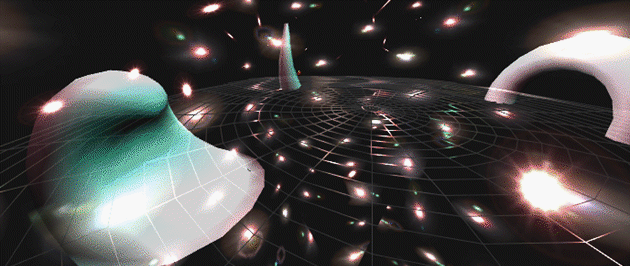 |
|---|
| The Main Universe |
"ORGWORLD" is a virtual reality application designed for the Immersadesk(TM). The Immersadesk is a drafting-table format projection-based virtual reality display using stereo glasses and sonic head and hand tracking. My goal was to bring a static object to life, in the process making it a creature by giving it motion, behavior, and a distinct personality. Virtual Reality seemed like an appropriate medium for this, due to its qualities of immersiveness and interactivity. The user is actually placed within the environment of the creatures, rather than passively observing them from afar. While in this world, their actions affect the behavior of the creatures, and the creatures influence what the user does.
When the user begins the application, they start out in an area known as "The Main Universe". This is a mysterious yet tranquil place filled with gently falling starflakes. The floor is a glistening, undulating web. Upon the web sit three translucent shapes: a truncated cone, a half-torus, and a paraboloid. When the users travels into one of the shapes, they are transported into the world of that shape. First they experience the journey to the particular world, which is a brief flight in which the user has no control over navigation. This is a transitional device, to ease the change between worlds. Once in the new world, the user is free to explore and interact with the virtual environment using a 3D interactive device known as the "wand". The wand allows for navigation within the space, as well as choosing options. Shapes in "The Main Universe" are icons for the various virtual worlds, echoing the living creatures within the environments. They are static symbols that are transformed into living creatures. The two main characteristics that give them life are motion and behavior.
Motion
The motion for all the shapes is based on IOTA. IOTA takes the individual vertices that compose a parametric shape and multiplies them by a transformation matrix and an increasing or decreasing value. The result is a shape which is constantly changing itself in real time, according to a regular mathematical formula. Factors which influence the way the object transforms are the morphology of the original shape, the center of the shape, and the particular transformation matrix. The shapes and transformations for ORGWORLD were chosen based on their resemblance to natural organisms and their movements.
Behavior
The behavior of the creatures in their environments was primarily based on the distance between the user and the creature, or the distance between the creature and its herd-mates. Each of the three types of creatures would react to the user in a different way, depending on their personality. Creatures were categorized as Manatees: The Gregarious, Tentacles: The Hostile, and Slinkies: The Indifferent.
Manatees: The Gregarious
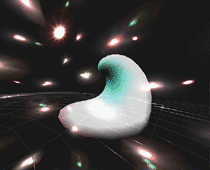 |
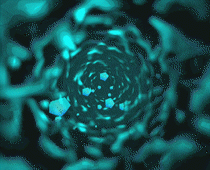 |
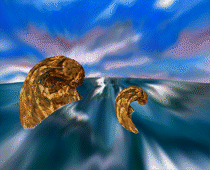 |
|---|---|---|
| Portal to Manatees | Journey to Manatees | Manatees |
The Manatees are friendly, happy creatures. There are three of these aquatic animals, which come to the surface and descend into the water. The journey to their world is from underwater, from the dark bubbly depths into a world of sky, sea, and Manatees. While the Manatees are surfacing and descending, they are also undulating back and forth to make a wave-like shape, which echoes the waves in the water surrounding them. If the participant is in close proximity to a Manatee, the Manatee surfaces and follows them around the environment. The Manatee is careful not to collide with the participant or other manatees.
Tentacles: The Hostile
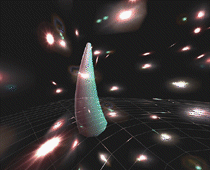 |
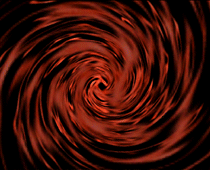 |
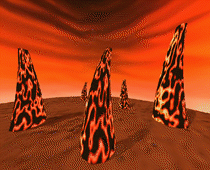 |
|---|---|---|
| Portal to Tentacles | Journey to Tentacles | Tentacles |
The Tentacles are hostile and unfriendly. After a jarring journey through a swirling spiral, you enter the harsh land where they live. It is dry and barren except for the Tentacles sticking up for the ground. At first their motion is almost imperceptible, but the closer the participant gets to them, the more agitated they become, writhing faster and faster. When the approach is too close, they begin to fire projectiles at the participant's head. This causes most people to back away very quickly, as we have no defenses against them.
Slinkies: The Indifferent
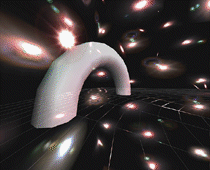 |
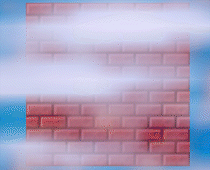 |
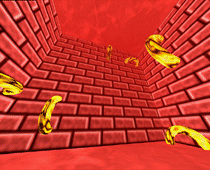 |
|---|---|---|
| Portal to Slinkies | Journey to Slinkies | Slinkies |
The Slinkies are largely indifferent to the presence of people, being more preoccupied with their current predicament. After flying through the clouds, the participant is slammed into the brick cubicle in the Slinkies are trapped. In this claustrophobic place Slinkies mindlessly pace up and down the walls, unable to escape. The user is able to float up and down in the cube and navigate within the space, but are trapped within the walls of the environment, just like the Slinkies.
Summary
"ORGWORLD" deals with creatures that exhibit behavior and inhabit unique environments. The user can explore these environments and interact with the creatures, influencing their behavior and being influenced by them.
MFA SHOW
 |
|---|
| Gallery Layout for Show |
My Master of Fine Arts show, "Divine Organic Push/Pop", opened on Wednesday May 8th at Gallery 400 on the UIC campus, and ran for a week. Showing with me were fellow EVL MFA candidates, Tom Coffin and Misha Caylor. The installation consisted of a Video Theater, Immersadesk, 2D art, sculpture and interactive installations. My main focus was on the video environment and Immersadesk setup.
Video Theater
It was very important to me that "A Small Comfort" be shown in the right setting, so the audience could watch the program. The typical video setup in gallery showings consists of a small monitor placed on a pedestal. This is frequently perceived as an installation, where viewers look at the monitor briefly, and then move on. This was not suitable for "A Small Comfort". I wanted people to sit down in a dark, quiet, comfortable setting and watch the whole thing on a large screen. So it was necessary to set up the Video Theater.The Video Theater was a system of walls made of metal struts with drywall over them. They were arranged to fit in the corner of the gallery, creating a small semi-enclosed room with an entrance near the front. The corner walls of the gallery were painted black, and the walls of the video theater were draped with black fabric. A projection screen was hung in the corner, and a video projector hung suspended in the opposite corner. Chairs were placed in the middle of the floor. Sound was provided through speakers on either side of the projection screen, and a small monitor on a pedestal was placed right before the entrance way to lure people in.
The video program consisted of "A Small Comfort" and works provided by the other artists. Since the show would be up for a week, a video loop which could automatically rewind and play was constructed. The program began with an animation of the show's logo I created in Softimage and was followed by each of our pieces.
The only problem with the Video Theater was in the area of sound. Noise from outside such as the Immersadesk and people talking was quite audible at times inside the theater. The solution would have been more soundproofing. But overall the Video Theater was successful in providing a comfortable place to watch videos within a gallery situation.
2D Art
2D stills from "A Small Comfort" were displayed within the gallery. They were arranged sequentially like a storyboard, with nine images on a page, but were more like a comic strip. The output was FujiX prints, a photographic process from a digital file. The colors were very rich and image quality quite sharp, and they were relatively inexpensive.
The Immersadesk
The other major setup was that of the Immersadesk. The Immersadesk, SGI Onyx Infinite Reality Engine, and associated equipment were transported from EVL by truck. Careful consideration was made to conceal the equipment from the public. The keyboard, mouse, tracker PC and amplifier were positioned under a table draped with a black curtain. The only things visible were the stereo glasses on top of the table, the Onyx behind the table, the speakers and the Immersadesk.Immersadesk applications consisted of "ORGWORLD" and Tom Coffin's "Push/Pop". A shell script was used to do the transition between applications, so the mouse and keyboard did not have to be touched. This script ran in an infinite loop, starting one application as soon as the other exited. Both applications incorporated identical wand controls, which made restarting and exiting applications easy and accessible.
The opening was very well attended, and many people came in particular to see virtual reality. A ticketing system to see the Immersadesk had been briefly considered, but that seemed inappropriate for a gallery setting. As it turned out, most everyone got to see the Immersadesk. During the actual opening reception we switched applications about every 20 minutes, so each of us could guide visitors through our work. During the rest of the week, when there were fewer people, we would show each visitor both works.
"Divine Organic Push/Pop" marked the first time the Immersadesk had been publicly exhibited in an art gallery setting. It worked out very well, and hopefully will be seen in many galleries in the future.